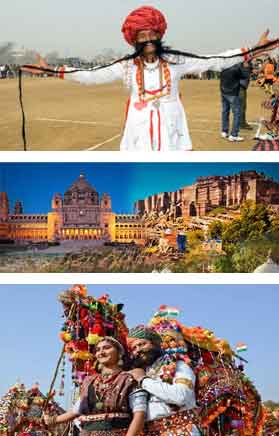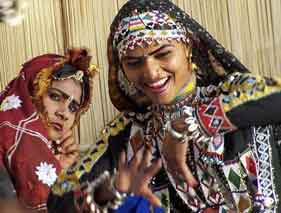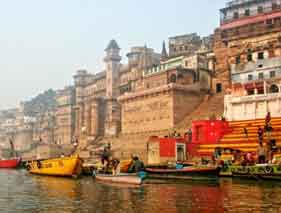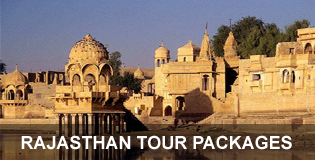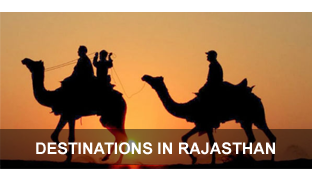Pushkar Fair with Ganges
Duration : 15 Nights/ 16 Days
Destinations Covered : Delhi - Jodhpur - Pushkar - Jaipur - Agra - Orcha - Khajuraho - Varanasi - Delhi
Highlights of Tour :
Delhi - Jodhpur - Pushkar - Jaipur - Agra - Orcha - Khajuraho - Varanasi - Delhi
Itinerary Details
Arrive Delhi and transfer to hotel and overnight stay
The walled gates of the Old city with visits to the Jama Masjid Mosque (1650) and a walk through the fabled area of Chandni Chowk (aptly translates to Moonlight Square) where the throngs of shoppers and vendors meet in the oldest area of Delhi. The spice market will be one of our visits.
Lakshmi Narayan Temple or popularly known as Birla Mandir , this temple is located next to Connaught Place. Gurudwara Bangla Sahib just off Baba Kharak Singh Marg near Connaught Place, is the main gurudwara for the many Sikhs of Delhi. The Jantar Mantar – an astronomical observatory built in 1724 – large abstract structures in the middle of a park – near Connaught Place. The Rajpath and India Gate – this is a main parade route that leads from India Gate with grassy lawns along the way.
In the old city we’ll take a ride on cycle rickshaws - 3-wheel cycles with a sofa seat at the back.
The Qutab Minar, 72 meters high and one of the most perfect towers in the Persian world. The Qutub complex in Mehrauli, houses structures dating from the Slave Dynasty (1206-1290) and is designated as a UNESCO World Heritage Site.
Humayun's Tomb in south Delhi, near Hazrat Nizamuddin station, is one of Delhi's three UNESCO World Heritage Sites. The centerpiece is the of Humayun, the second Mughal emperor. Built starting in 1562, it was the first major Mughal structure in the city and has been described as a predecessor or prototype of Agra's Taj Mahal.
Bahá'í Lotus Temple Kalkaji, South Delhi - shaped like a lotus bud with 27 petals, this stunning temple suspended above milky-blue ponds is surely one of the most magnificent monuments ever made from concrete, however there is very little to see inside. The lush park around is well landscaped but mostly off-limits.
Overnights at Hotel Jivitesh - a modern, stylish hotel near old Delhi, a wonderful breakfast.
After breakfast transfer to airport and fly to Jodhpur. Check in at your hotel and later proceed to explore the town. Jodphur has a population of just over one million and its' climate is generally hot and semi-arid, with a rainy season from late June to September. Temperatures in November are likely to be in the low to mid 30s. Jodhpur is the centre for many handicraft industries.
We will explore Jodhpur and its' district. The Mehrangarh Fort is one of the largest forts in India. The fort is situated 400 feet (122 m) above the city and is enclosed by imposing thick walls. Inside its boundaries there are several palaces known for their intricate carvings and expansive courtyards. A winding road leads to and from the city below. The imprints of cannonball hits by attacking armies of Jaipur can still be seen on the second gate.
To the left of the Mehrangarh Fort complex is the beautiful Jaswant Thada - a white marble memorial built by Maharaja Sardar Singh of Jodhpur State in 1899 in memory of his father, Maharaja Jaswant Singh II. The monument is built out of intricately carved sheets of marble. These stones are extremely thin and polished so that they emit a warm glow when the sun's rays dance across their surface. Best visited as soon as it opens.
The Sardar Bazaar - clustered around a clock tower - is in the heart of the old city - the market sells silver, bangles, tie-dyed fabrics, camel leather shoes, puppets, spices, sweets etc. The 17th century Taleti Mahal is in this area - with its intricate carved balconies - and there are other beautiful houses in this part of the city. A bustling, vibrant area full of street life, traders, tailors etc all spilling out onto the pavement.
The Blue City - set underneath the castle, this area of the city has homes and small shops, clinging to steep lanes. The 'milk wallahs' can be seen delivering milk to households from a churn on the back of motorbikes. Fascinating to walk through, this area is also a good (or bad) example of the tattiness of many Indian streets - lots of litter, cows (and their mess) all over. On the other hand, we may come across some lovely scenes of boys playing cricket in the alleys.
Wonderful opportunities for shopping here for 'throws' and woven goods.
Craft villages - The arid countryside south of Jodhpur is dotted with mud-and-thatch villages inhabited by the Bishnois (who believe that they will be reborn as deer and whose women wear elaborate nose-jewellery) and communities of potters and weavers. Villages include: Saawas (weaving); Kakuni (pottery) Gudda Bishnoi (camels and goats).
Overnights in Hotel Park Plaza. This is quite an amazing hotel - top class.
The distance between Jodhpur and Pushkar is 185km but this is India - so we'll allow 5 hours for the journey - there will be plenty of interest on the way.
The Pushkar Camel Fair or Mela - might be said to stretch over 12 days - we arrive as the official programme begins on the 18th and our four days here are crowded with activities - the trading of camels and horses; horse and camel races; camel dancing competitons, hordes of pilgrims down in the lake area, hundreds of sadhus converge on the town - which is full of stalls selling everything imaginable - good bargains for clothes, leather goods, paper and note-books.
Most people associate the Pushkar Fair with the world's largest camel fair. But it is much more than that. It is an occasion for villagers from far and near to gather together and enjoy a welcome break from their harsh life of the arid desert. It is also an occasion for Hindu pilgrims to converge for a holy dip in the sacred Pushkar Lake to 'wash away the sins of a lifetime'. According to legend, the origin of Pushkar dates back to the time when Lord Brahma was on his way in search of a tranquil land to perform a ‘Yagna’. A lotus fell from the hand of the Lord into this valley. A lake sprang up on this spot and was dedicated to him. A Brahma temple located here which is supposed to be the only temple dedicated to this God, is a popular place of pilgrimage. Of course, the event has become a major tourist attraction and as such there will be many commercial aspects of the fair - there's a good deal of debate in India about the nature of religious and cultural occasions and how they have been 'captured' by commercialism - a potential theme for photography in itself.
We will not certainly not lack photographic opportunites - from the traders/herders and their camps to the various animals and events involving them - trading/races, beauty contests, animal dance competitions etc; from the pilgrims and the ghats on Pushkar lake to the funfair, competitions ranging from moustache contests to football and cricket matches; from craft markets to dancing and wrestling. An optional hot air balloon ride offers a different viewpoint and there are lots of evening events too.
Hotel Master Paradise for the duration of the stay - all meals included. Hotel Paradise is a three star hotel, set in nice private gardens with swimming pool - just 10 minutes walk from the centre. I stayed here in 2014 - it's a little quirky - the electricity goes off occasionally and hot water supply can be a little erratic - so it lacks the polish our other hotels have - but we were looked after really well by the staff and the food was plentiful and excellent. Pushkar is a vegetarian (and 'dry') town.
Drive to jaipur which is just 150 kms way from Pushkar. Check in at the hotel and later proceed to explore teh best of it.
The Amer Fort, situated in Amber, 11 kilometers from Jaipur, is one of the most famous forts of Rajasthan - built in 1592. This fort is also very popularly known as the Amer Palace. The Amer Fort was built in red sandstone and marble and the Maotha Lake adds a certain charm to the entire Fort. From the outside it is quite spectacular - inside it is a little bare and rather disappointing.
Located in the heart of the Pink City Jaipur, is the City Palace. The palace is located towards the northeast side of central Jaipur and has many courtyards and buildings. The palace was built between 1729 and 1732
The renowned 'Palace Of The Winds', or Hawa Mahal, is one of the prominent tourist attractions in Jaipur city. Located in the heart of Jaipur, this beautiful five-storey palace was constructed in 1799 - and is built of red and pink sandstone. The palace is believed to have been constructed in the form of the crown of Krishna, the Hindu god. Considered as an embodiment of Rajputana architecture, the main highlight of Hawa Mahal is its pyramid shape and its 953 windows or 'Jharokhas' which are decorated with intricate designs. The main intention behind the construction of the Mahal was to facilitate the royal women and provide them a view of everyday life through the windows, as they never appeared in public.
Jaipur is a vibrant town with a range of shops - an evening of retail therapy may be irrestible - or a night at the cinema.
After breakfast drive to Agra. En route stop at Fatehpur Sikri, the deserted sandstone city, which was the glorious but short-lived imperial capital of Akbar, the greatest of Mughal emperors. Lying on a rocky ridge, it is today a haunting complex of empty palaces, forts and mosques. A variety of architectural styles are found, since craftsmen representing many schools were employed. Continue drive to Agra and check in at the hotel.
later proceed to visit Tāj Mahal was built by the Mughal king Shah Jahan as the final resting place for his beloved wife, Mumtāz Mahal. Finished in marble, it is perhaps India's most beautiful monument. This perfectly symmetrical monument took 22 years (1630–1652) of labour and 20,000 workers, masons and jewellers to build and is set amidst landscaped gardens. It is an acknowledged masterpiece of symmetry. Verses of the Koran are inscribed on it and at the top of the gate are twenty-two small domes, signifying the number of years the monument took to build. The Tāj Mahal was built on a marble platform that stands above a sandstone one. The most elegant dome of the Tāj Mahal has a diameter of 60 feet (18 m), and rises to a height of 80 feet (24 m); directly under this dome is the tomb of Mumtāz Mahal. Shah Jahān's tomb was erected next to hers by his son Aurangzeb. The interiors are decorated with fine inlay work, incorporating semi-precious stones. Overnight at Hotel in Agra
Other visits in Agra might include either the Agra Fort or the Mankameshwar Temple and markets. Agra Fort is a UNESCO World Heritage and is also known as Lal Qila, Fort Rouge and Red Fort of Agra. It is about 2.5 km northwest of its much more famous sister monument, the Taj Mahal. The fort can be more accurately described as a walled palatial city. Agra Fort was re-built in red sandstone from existing ruins - completed in 1573. It has bricks in the inner core with sandstone on external surfaces. Of the nearly 500 Akbari buildings built in the Bengal and Gujarati traditions only a few have survived, arrayed in a band on the riverfront.
Proceed to Orcha. We found Orchha to be a fascinating and very interesting destination - a small, lively town with a population of around 6,000. We stay in a wonderful hotel.
Orchha is dramatically situated on a rocky island, enclosed by a loop of the Betwa River. Founded in 1531, it was the capital of the Bundela kings until 1738, when it was abandoned. Crumbling palaces (the Jahangiri Mahal, the Raj Mahal and Rai Mahal are the most impressive), pavilions, 'bamams', walls and gates connected to the town by a 14-arched causeway are all that remain.
The old town is dominated by three beautiful temples - Ram Raja, the Laskshmi and the Chaturbhuj. Along the Kanchana Ghat of the Betwa are 14 hauntingly beautiful cenotaphs of the Orchha rulers. Other places to visit are the Sunder Mahal, Laxminarayan Temple and the Phool Bagh.
Sunder Mahal: This small palace, almost in ruins today is still a place of pilgrimage for Muslims. Dhurjban, son of Jhujhar, embraced Islam when he wed a Muslim girl at Delhi. He spent the latter part of his life in prayer and meditation and came to be revered as a saint.
Overnights in Hotel in Orchha.
After an early breakfast, we depart for the drive to Khajuraho - about 170 kms (three hours) ready for an early afternoon tour of the amazing temple complex.
There are 25 temples at Khajuraho - built in the ninth and tenth centuries. The remoteness of the temples saved them from the ravages of Islamic invaders but they were abandoned in the thirteenth century.
The most impressive temple is the Kanariya Mahadev - over 800 sculptures cover the temple - depicting gods and goddesses, beasts and warriors, sensuous maidens, dancers, musicians and erotic scenes.
The temples are divided into three groups - the most important are the western group which includes the Laksham and Vishwanath temples.
An interesting shopping location in the evening.
Overnight in Hotel Clarks - lovely hotel in large grounds.
Morning visiting the local villages near Khajuraho - afternoon flight (50 mins) to Varanasi. Evening visit to the ghats along the Ganges in Varanasi and overnight stay.
We found exploring Varanasi and the area around it an amazing experience - we discovered little villages and towns just out of town - it was amazing to witness hordes of school children emerging from their homes and little hamlets and coming together in great streams of humanity as they neared the schools.
The chaotic city is quite possibly the world’s oldest living city. It is also a city of many names. This is the city of Shiva. The present name, Varanasi (derived from the names of two nearby rivers), is mentioned in the Mahabharata. The ancient name is Kashi, the City of Light. To the devout it is also called Kashika, the shining one, referring to the light of Shiva. Many others prefer the anglicised Benares. Revered by Hindus, Buddhists and Jain alike, Varanasi is considered the holiest city in all of India. As a result, more Indians will make a pilgrimage to Varanasi in their lifetime than any other place.
Every morning at dawn hundreds of worshippers can be seen bathing in the sacred waters. The great river banks are lined with an endless chain of stone steps - the ghats - that stretch from one end of the city to the other - over 6 kilometres. . The Ghats form an impressive part of the religious landscape of the city. Life and death go hand in hand in Varanasi.
The centrally located ghats are most holy and Dashashwamedh Ghat is perhaps the most specactular - every evening a group of priests perform 'Agni Pooja' (Worship pf Fire) where a dedication is made to Lord Shiva, River Ganga, the Sun and Fire and the Universe. Behind the ghat, a winding lane is crowded with shops selling religious items. It leads to the city's principal shrine - the Vishwanath Temple - said to be over 1,000 years old. Darbhanga ghat is dominated by the towers and turrets of havelis built in the early 1900s. Manikarnika and Harishchandra are the two cremation ghats.
Varanasi has many small scale cottage industries including baranarasi silk sari making and hand-woven carpets. It will be really interesting to see some of these small scale industries - we visited a muslim area where the looms were in the ground floor and accommodation upstairs.
Sarnath, located 6 miles (9 km) from Varanasi, which is the centre of the Buddhist world, just as Varanasi is that for the Hindu. It was here that Buddha preached his first sermon, partially recorded on one of its stones. Dhamek Stupa dating back to 500 AD, is the largest with geometrical ornaments on its wall. Dharmarajika Stupa was set up by emperor Ashoka to contain the bodily relics of the Buddha. There is an outstanding museum, worth visiting. Overnight in Varanasi
Final morning in Varanasi. Early afternoon transfer to airport to board a flight for Delhi. arrives in New Delhi we will be met by a representative of the travel company and escorted to our hotel near the airport. Overnight at Hotel in Delhi
Transfer to New Delhi International airport to board flight for onward destination.
